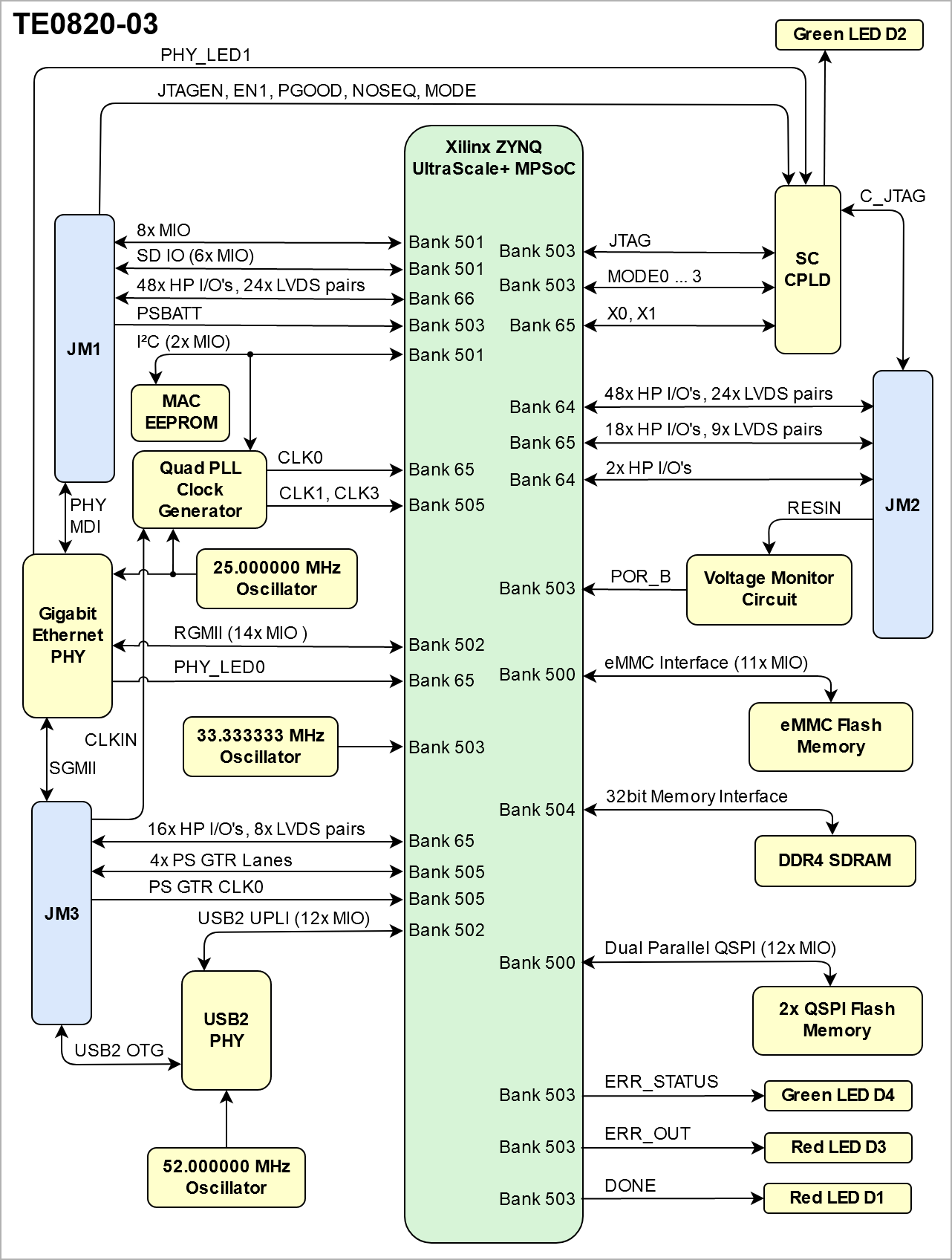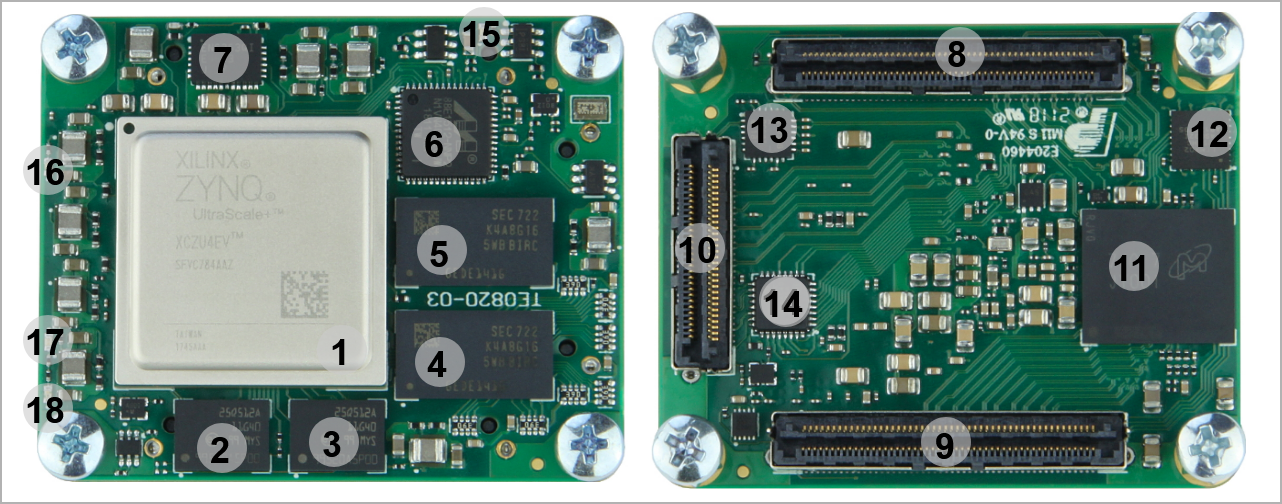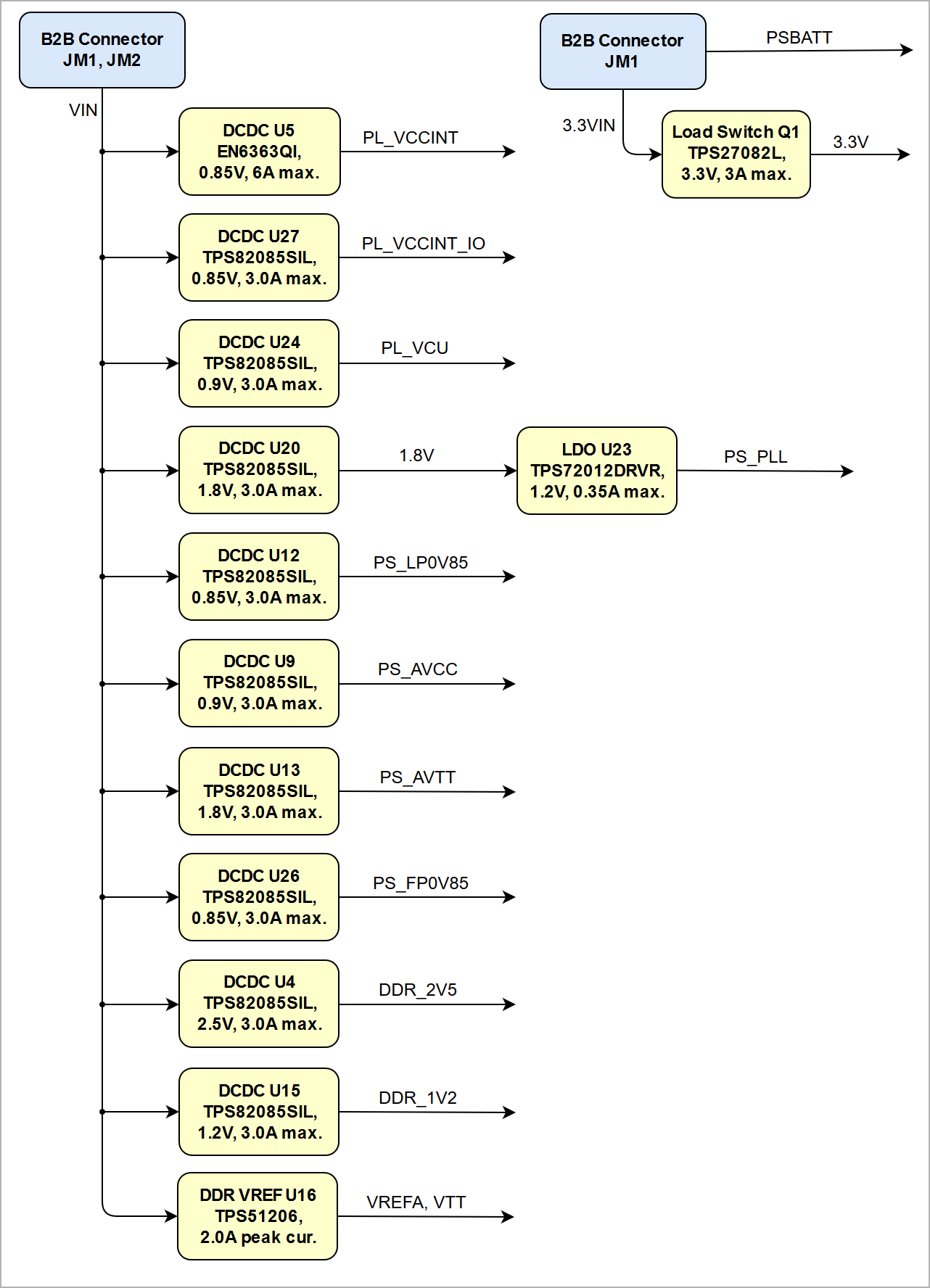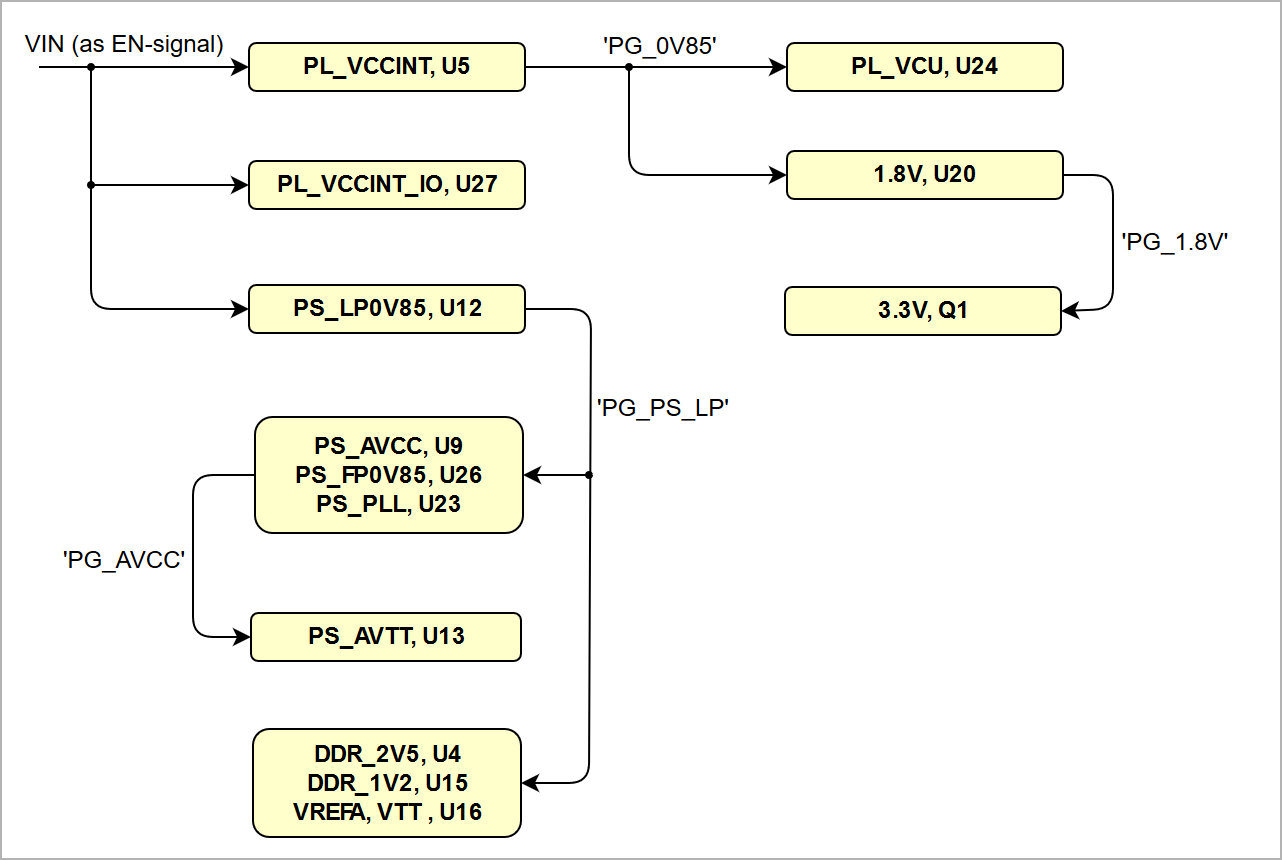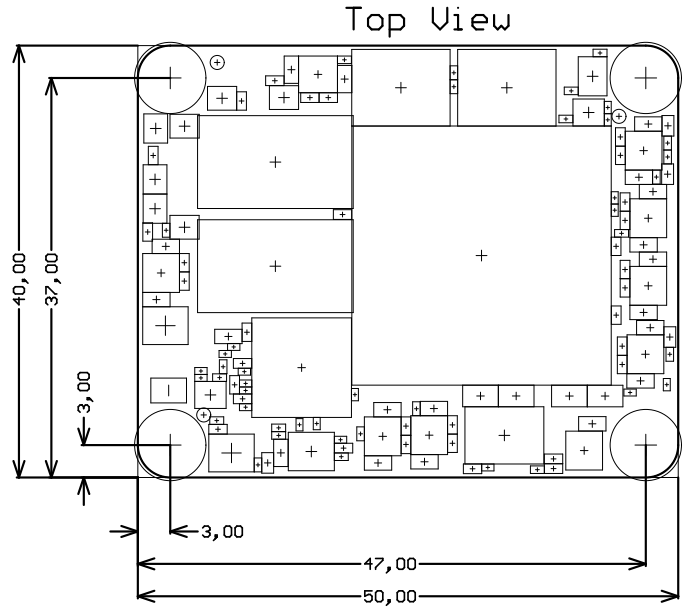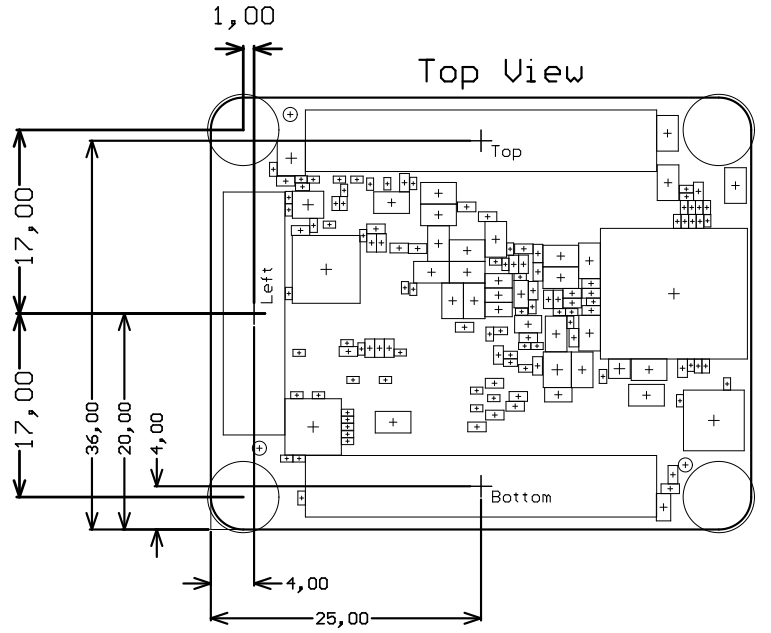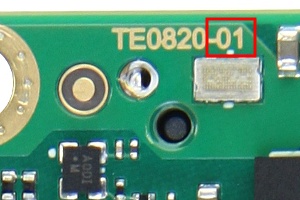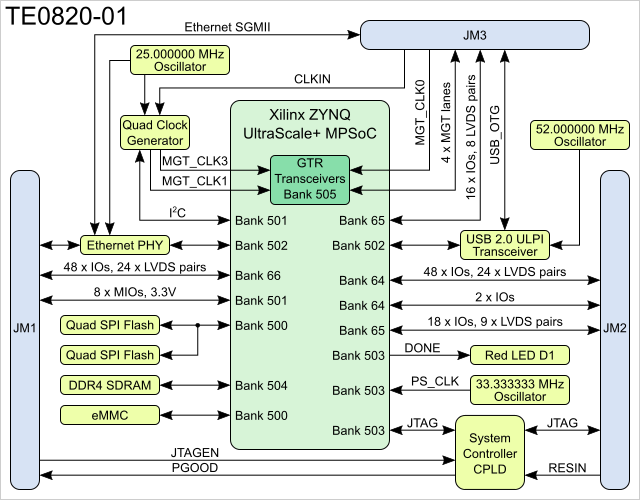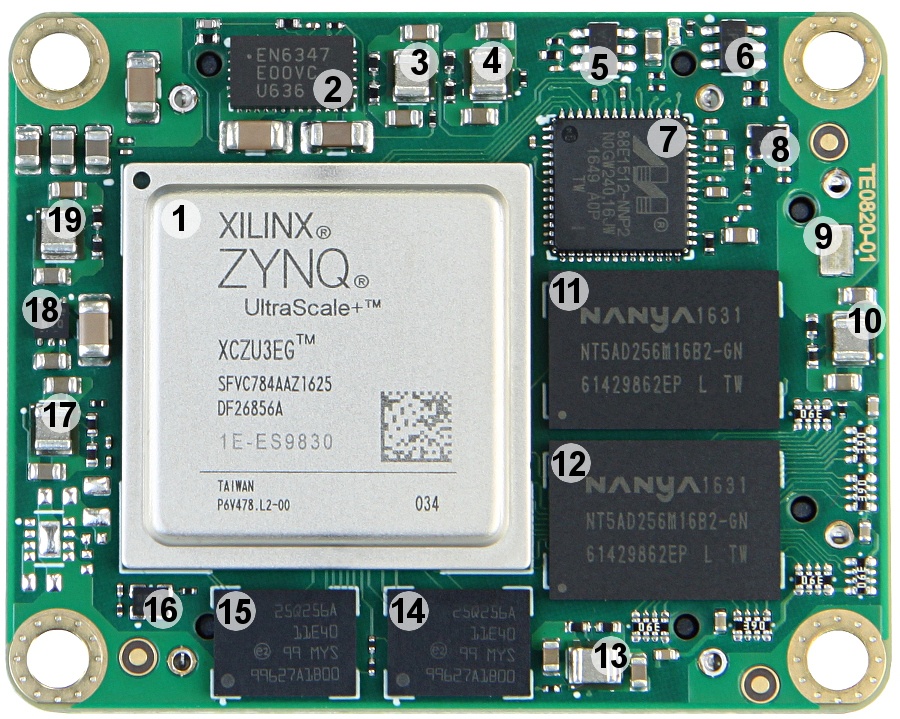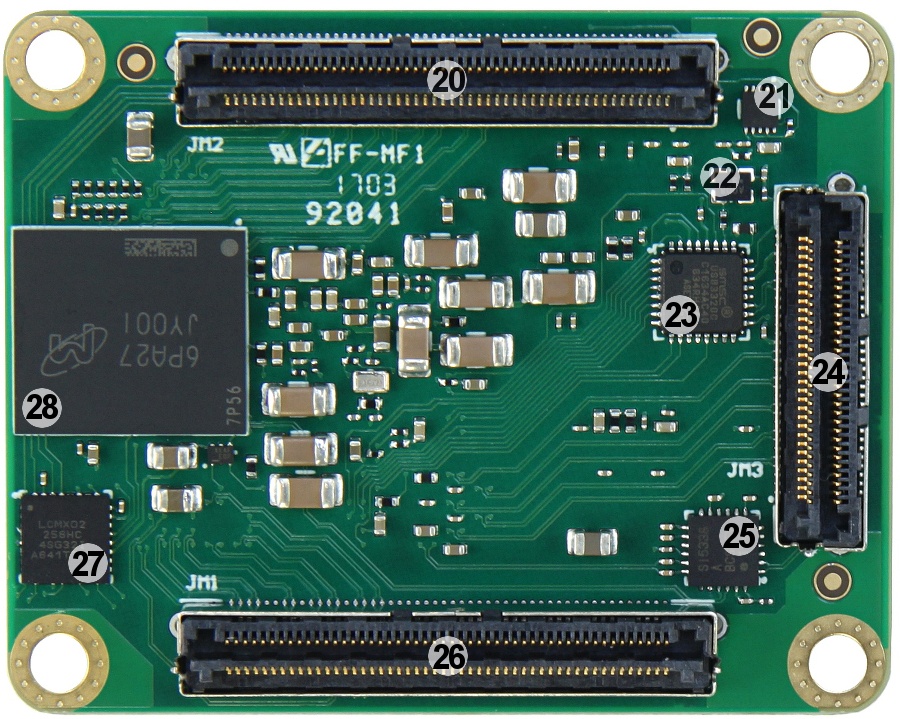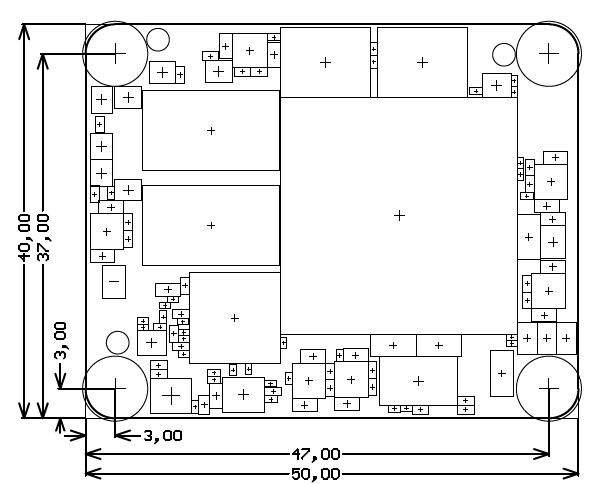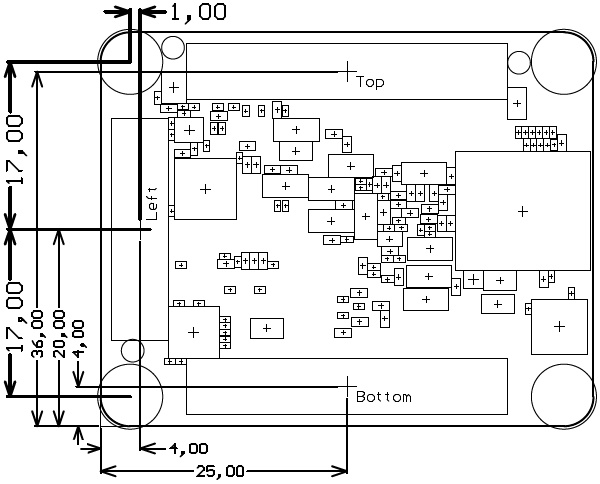Page History
| HTML |
|---|
<!--
Template Revision 1.68
(HTML comments will be not displayed in the document, no need to remove them. For Template/Skeleton changes, increase Template Revision number. So we can check faster, if the TRM style is up to date).
--> |
| HTML |
|---|
<!--
General Notes:
If some section is CPLD firmware dependent, make a note and if available link to the CPLD firmware description. It's in the TE shop download area in the corresponding module -> revision -> firmware folder.
--> |
| HTML |
|---|
<!--
General Notes:
Designate all graphics and pictures with a number and a description. For example "Figure 1: TE07xx-xx Block Diagram" or "Table 1: Initial delivery state". "Figure x" and "Table x" have to be formatted to bold.
--> |
| HTML |
|---|
<!--
Link to the base folder of the module (remove de/ or en/ from the URL): for example:
https://shop.trenz-electronic.de/Download/?path=Trenz_Electronic/Modules_and_Module_Carriers/4x5/4x5_Carriers/TE0703/
--> |
| Scroll Ignore |
|---|
| Scroll pdf ignore | |
|---|---|
Table of Contents
|
Overview
The Trenz Electronic TE0820 is an industrial-grade 4 x 5 cm MPSoC SoM (System on Module) module integrating a Xilinx Zynq UltraScale+ with up to 4 GByte 32-Bit DDR4 SDRAM, max. 128 MByte SPI Boot Flash memory for configuration and operation and powerful switch-mode power supplies for all on-board voltages. A large number of configurable I/Os is provided via rugged high-speed stacking strips. All Trenz Electronic SoMs in 4 x 5 cm form factor are mechanically compatible.
| HTML |
|---|
<!--
Use short link the Wiki Ressource page: for example:
http://trenz.org/te0720-info
List of available short links: https://wiki.trenz-electronic.de/display/CON/Redirects
--> |
| Scroll Only (inline) |
|---|
Refer to http://trenz.org/te0820-info for the current online version of this manual and other available documentation.
|
Key Features
- Xilinx Zynq UltraScale+ MPSoC (XCZU2CG / XCZU2EG, XCZU3CG / XCZU3EG or XCZU4CG / XCZU4EV)
- Quad-core or dual-core Cortex-A53 64-bit ARM v8 application processing unit (APU) (depends on assembly variant CG,EG,EV)
- Dual Cortex-R5 32-bit ARM v7 real-time processing unit (RPU)
Four high-speed serial I/O (HSSIO) interfaces supporting following protocols:
- PCI Express® interface version 2.1 compliant
- SATA 3.1 specification compliant interface
DisplayPort source-only interface with video resolution up to 4k x 2k
- USB 3.0 specification compliant interface implementing a 5 Gbit/s line rate
- 1 GB/s serial GMII interface
- 132 x HP PL I/Os (3 banks)
- 14 x PS MIOs (6 of the MIOs intended for SD card interface in default configuration)
- 4 x serial PS GTR transceivers
- 2 GByte DDR4 SDRAM, 32bit databus-width
- 128 MByte QSPI boot Flash in dual parallel mode
- 8 GByte eMMC
- Programmable quad PLL clock generator PLL for PS GTR clocks (optional external reference)
- Gigabit Ethernet transceiver PHY (Marvell Alaska 88E1512)
- MAC address serial EEPROM with EUI-48™ node identity (Microchip 24AA025E48)
- Hi-speed USB2 ULPI transceiver with full OTG support (Microchip USB3320C)
- Plug-on module with 2 x 100-pin and 1 x 60-pin high-speed hermaphroditic strips
- All power supplies on board
- Size: 50 x 40 mm
Additional assembly options are available for cost or performance optimization upon request.
Block Diagram
| HTML |
|---|
<!--
Rules for all diagrams:
1. All diagrams are wrapped in the "Scroll Title" macro.
- The title has to be named with the diagrams name
- The anchor has the designation figure_x, whereby x is the number of the diagram
2. The Draw.IO diagram has to be inserted in the "Scroll Ignore" macro
- Border has to be switched off in the macro edit
- Toolbar has to be hidden in the macro edit
3. A PNG Export of the diagram has to be inserted in the "Scroll Only" macro
The workaround with the additional PNG of the diagram is necessary until the bug of the Scroll PDF Exporter, which cuts diagram to two pages, is fixed.
IMPORTANT NOTE: In case of copy and paste the TRM skeleton to a new Wiki page, delete the Draw.IO diagrams and the PNGs, otherwise due to the linkage of the copied diagrams every change in the TRM Skeleton will effect also in the created TRM and vice versa!
See page "Diagram Drawing Guidelines" how to clone an existing diagram as suitable template for the new diagram!
--> |
| Scroll Title | ||||||||||||||||||||||||||||
|---|---|---|---|---|---|---|---|---|---|---|---|---|---|---|---|---|---|---|---|---|---|---|---|---|---|---|---|---|
| ||||||||||||||||||||||||||||
|
Main Components
| Scroll Title | ||||||||||||||||||||||||||||
|---|---|---|---|---|---|---|---|---|---|---|---|---|---|---|---|---|---|---|---|---|---|---|---|---|---|---|---|---|
| ||||||||||||||||||||||||||||
|
- Xilinx Zynq UltraScale+ MPSoC, U1
- 1.8V, 512 Mbit QSPI flash memory, U7
- 1.8V, 512 Mbit QSPI flash memory, U17
- 8 Gbit (512 x 16) DDR4 SDRAM, U2
- 8 Gbit (512 x 16) DDR4 SDRAM, U3
- Marvell Alaska 88E1512 integrated 10/100/1000 Mbps energy efficient ethernet transceiver, U8
- 6A PowerSoC DC-DC converter (PL_VCCINT, 0.85V), U5
- B2B connector Samtec Razor Beam™ LSHM-150, JM1
- B2B connector Samtec Razor Beam™ LSHM-150, JM2
- B2B connector Samtec Razor Beam™ LSHM-130, JM3
- 8 GByte eMMC memory, U6
- Lattice Semiconductor MachXO2 System Controller CPLD, U21
- I2C programmable, any frequency , any output quad clock generator, U10
- Highly integrated full featured hi-speed USB 2.0 ULPItransceiver, U18
- LED D1(Red) Done Pin
- LED D2 (Green) CPLD Status, User LED
- LED D3 (Red) PS Error
- LED D4 (Green) PS Error Status
Initial Delivery State
| Storage Device Name | Content | Notes |
|---|---|---|
SPI Flash OTP Area | Empty, not programmed | Except serial number programmed by flash vendor. |
SPI Flash Quad Enable bit | Programmed | - |
SPI Flash main array | Not programmed | - |
eFUSE USER | Not programmed | - |
eFUSE Security | Not programmed | - |
| Si5338 OTP NVM | Not programmed | - |
| CPLD (LCMXO2-256HC) | SC0820-02 QSPI Firmware | See Boot Process section. |
Table 1: Initial delivery state of programmable devices on the module
Boot Process
Two different firmware versions are available, one with the QSPI boot option and other with the SD Card boot option.
| B2B JM1 MODE Pin | Default CPLD Firmware | QSPI Firmware Version | SD Card Firmware Version |
|---|---|---|---|
| Low | SD | JTAG | Boot from SD Card |
| High | Flash | Boot from Flash | JTAG |
Table 2: Boot mode pin description
For more information refer to the TE0820 CPLD - BootMode section.
Signals, Interfaces and Pins
Board to Board (B2B) I/Os
Zynq MPSoC's I/O banks signals connected to the B2B connectors:
| Bank | Type | B2B Connector | I/O Signal Count | Voltage | Notes |
|---|---|---|---|---|---|
64 | HP | JM2 | 48 | User | Max voltage 1.8V |
64 | HP | JM2 | 2 | User | Max voltage 1.8V |
| 65 | HP | JM2 | 18 | User | Max voltage 1.8V |
65 | HP | JM3 | 16 | User | Max voltage 1.8V |
66 | HP | JM1 | 48 | User | Max voltage 1.8V |
| 500 | MIO | JM1 | 8 | 1.8V | - |
501 | MIO | JM1 | 6 | 3.3V | - |
505 | GTR | JM3 | 4 lanes | - | - |
505 | GTR CLK | JM3 | 1 differential input | - | - |
Table 3: General overview of board to board I/O signals
For detailed information about the pin-out, please refer to the Pin-out table.
MGT Lanes
The Xilinx Zynq UltraScale+ device used on the TE0820 module has 4 GTR transceivers. All 4 are wired directly to B2B connector JM3. MGT (Multi Gigabit Transceiver) lane consists of one transmit and one receive (TX/RX) differential pairs, four signals total per one MGT lane. Following table lists lane number, FPGA bank number, transceiver type, signal schematic name, board-to-board pin connection and FPGA pins connection:
| Lane | Bank | Type | Signal Name | B2B Pin | FPGA Pin |
|---|---|---|---|---|---|
| 0 | 505 | GTR |
|
|
|
| 1 | 505 | GTR |
|
|
|
| 2 | 505 | GTR |
|
|
|
| 3 | 505 | GTR |
|
|
|
Table 4: MGT lanes
There are 3 clock sources for the GTR transceivers. B505_CLK0 is connected directly to B2B connector JM3, so the clock can be provided by the carrier board. Clocks B505_CLK1 and B505_CLK3 are provided by the on-board clock generator (U10). As there are no capacitive coupling of the data and clock lines that are connected to the connectors, these may be required on the user’s PCB depending on the application.
| Clock signal | Bank | Source | FPGA Pin | Notes |
|---|---|---|---|---|
| B505_CLK0_P | 505 | B2B, JM3-31 | PS_MGTREFCLK0P_505, F23 | Supplied by the carrier board |
| B505_CLK0_N | 505 | B2B, JM3-33 | PS_MGTREFCLK0N_505, F24 | Supplied by the carrier board |
| B505_CLK1_P | 505 | U10, CLK2A | PS_MGTREFCLK1P_505, E21 | On-board Si5338A |
| B505_CLK1_N | 505 | U10, CLK2B | PS_MGTREFCLK1N_505, E22 | On-board Si5338A |
| B505_CLK2_P | 505 | N/A | PS_MGTREFCLK2P_505, C21 | Not connected |
| B505_CLK2_N | 505 | N/A | PS_MGTREFCLK2N_505, C22 | Not connected |
| B505_CLK3_P | 505 | U10, CLK1A | PS_MGTREFCLK3P_505, A21 | On-board Si5338A |
| B505_CLK3_N | 505 | U10, CLK1B | PS_MGTREFCLK3N_505, A22 | On-board Si5338A |
Table 5: MGT reference clock sources
JTAG Interface
JTAG access to the Xilinx Zynq-7000 is provided through B2B connector JM2.
JTAG Signal | B2B Connector Pin |
|---|---|
| TMS | JM2-93 |
| TDI | JM2-95 |
| TDO | JM2-97 |
| TCK | JM2-99 |
Table 6: JTAG interface signals
Pin 89 JTAGEN of B2B connector JM1 is used to control which device is accessible via JTAG. If set to low or grounded, JTAG interface will be routed to the Xilinx Zynq MPSoC. If pulled high, JTAG interface will be routed to the System Controller CPLD.
System Controller CPLD I/O Pins
Special purpose pins are connected to System Controller CPLD and have following default configuration:
| Pin Name | Mode | Function | Default Configuration |
|---|---|---|---|
| EN1 | Input | Power Enable | No hard wired function on PCB. When forced low, PGOOD goes low without effect on power management |
| PGOOD | Output | Power Good | Only indirect used for power status, see CPLD description |
| NOSEQ | - | - | No used for Power sequencing, see CPLD description |
| RESIN | Input | Reset | Active low reset, gated to POR_B |
| JTAGEN | Input | JTAG Select | Low for normal operation, high for CPLD JTAG access |
Table 7: System Controller CPLD special purpose pins.
See also
- 4 x 5 SoM Integration Guide#4x5SoMIntegrationGuide-4x5ModuleControllerIOs
- TE0820 CPLD
- TE0820-REV01_REV02 CPLD
Default PS MIO Mapping
| PS MIO | Function | B2B Pin | Connected to | PS MIO | Function | B2B Pin | Connected to |
|---|---|---|---|---|---|---|---|
| 0 | SPI0 | - | U7-B2, CLK | 40..45 | - | - | Not connected |
| 1 | SPI0 | - | U7-D2, DO/IO1 | 46 | SD | JM1-17 | B2B, SD_DAT3 |
| 2 | SPI0 | - | U7-C4, WP/IO2 | 47 | SD | JM1-19 | B2B, SD_DAT2 |
| 3 | SPI0 | - | U7-D4, HOLD/IO3 | 48 | SD | JM1-21 | B2B, SD_DAT1 |
| 4 | SPI0 | - | U7-D3, DI/IO0 | 49 | SD | JM1-23 | B2B, SD_DAT0 |
| 5 | SPI0 | - | U7-C2, CS | 50 | SD | JM1-25 | B2B, SD_CMD |
| 6 | N/A | - | Not connected | 51 | SD | JM1-27 | B2B, SD_CLK |
| 7 | SPI1 | - | U17-C2, CS | 52 | USB_PHY | - | U18-31, OTG-DIR |
| 8 | SPI1 | - | U17-D3, DI/IO0 | 53 | USB_PHY | - | U18-31, OTG-DIR |
| 9 | SPI1 | - | U17-D2, DO/IO1 | 54 | USB_PHY | - | U18-5, OTG-DATA2 |
| 10 | SPI1 | - | U17-C4, WP/IO2 | 55 | USB_PHY | - | U18-2, OTG-NXT |
| 11 | SPI1 | - | U17-D4, HOLD/IO3 | 56 | USB_PHY | - | U18-3, OTG-DATA0 |
| 12 | SPI1 | - | U17-B2, CLK | 57 | USB_PHY | - | U18-4, OTG-DATA1 |
| 13..20 | eMMC | - | U6, MMC-D0..D7 | 58 | USB_PHY | - | U18-29, OTG-STP |
| 21 | eMMC | - | U6, MMC-CMD | 59 | USB_PHY | - | U18-6, OTG-DATA3 |
| 22 | eMMC | - | U6, MMC-CLKR | 60 | USB_PHY | - | U18-7, OTG-DATA4 |
| 23 | eMMC | - | U6, MMC-RST | 61 | USB_PHY | - | U18-9, OTG-DATA5 |
| 24 | ETH | - | U8, ETH-RST | 62 | USB_PHY | - | U18-10, OTG-DATA6 |
| 25 | USB_PHY | - | U18, OTG-RST | 63 | USB_PHY | - | U18-13, OTG-DATA7 |
| 26 | MIO | JM1-95 | B2B, as PJTAG MIO possible | 64 | ETH | - | U8-53, ETH-TXCK |
| 27 | MIO | JM1-93 | B2B, as PJTAG MIO possible | 65..66 | ETH | - | U8-50..51, ETH-TXD0..1 |
| 28 | MIO | JM1-99 | B2B, as PJTAG MIO possible | 67..68 | ETH | - | U8-54..55, ETH-TXD2..3 |
| 29 | MIO | JM1-97 | B2B, as PJTAG MIO possible | 69 | ETH | - | U8-56, ETH-TXCTL |
| 30 | MIO | JM1-92 | B2B (UART RX) | 70 | ETH | - | U8-46, ETH-RXCK |
| 31 | MIO | JM1-85 | B2B (UART TX) | 71..72 | ETH | - | U8-44..45, ETH-RXD0..1 |
| 32 | MIO | JM1-91 | B2B | 73..74 | ETH | - | U8-47..48, ETH-RXD2..3 |
| 33 | MIO | JM1-87 | B2B | 75 | ETH | - | U8-43, ETH-RXCTL |
| 34..37 | - | - | Not connected | 76 | ETH | - | U8-7, ETH-MDC |
| 38 | I2C | - | U10-12, SCL | 77 | ETH | - | U8-8, ETH-MDIO |
| 39 | I2C | - | U10-19, SDA | - | - | - | - |
Table 8: TE0820-03 PS MIO mapping
Gigabit Ethernet
On-board Gigabit Ethernet PHY is provided with Marvell Alaska 88E1512 chip. The Ethernet PHY RGMII interface is connected to the Zynq Ethernet0 PS GEM0. I/O voltage is fixed at 1.8V for HSTL signaling. SGMII (SFP copper or fiber) can be used directly with the Ethernet PHY, as the SGMII pins are available on the B2B connector JM3. The reference clock input of the PHY is supplied from an on-board 25MHz oscillator (U11), the 125MHz output clock is left unconnected.
Ethernet PHY connection
| PHY Pin | ZYNQ PS | ZYNQ PL | Notes |
|---|---|---|---|
| MDC/MDIO | MIO76, MIO77 | - | - |
| LED0 | - | K8 | Can be routed via PL to any free PL I/O pin in B2B connector. |
| LED1 | - | - | CPLD pin 17. |
| LED2 | - | - | Not connected. |
| CONFIG | - | - | Wired to the 1.8V. |
| RESETn | MIO24 | - | - |
| RGMII | MIO64..MIO75 | - | - |
| SGMII | - | - | Routed to the B2B connector JM3. |
Table 9: General overview of the Gigabit Ethernet PHY signals
USB Interface
USB PHY is provided by Microchip USB3320. The ULPI interface is connected to the Zynq PS USB0. I/O voltage is fixed at 1.8V. Reference clock input for the USB PHY is supplied by the on-board 52.000000 MHz oscillator (U14).
USB PHY connection
| PHY Pin | ZYNQ Pin | B2B Name | Notes |
|---|---|---|---|
| ULPI | MIO52..63 | - | Zynq USB0 MIO pins are connected to the USB PHY. |
| REFCLK | - | - | 52.000000 MHz from on-board oscillator (U14). |
| REFSEL[0..2] | - | - | Reference clock frequency select, all set to GND selects 52.000000 MHz. |
| RESETB | MIO25 | - | Active low reset. |
| CLKOUT | MIO52 | - | Connected to 1.8V, selects reference clock operation mode. |
| DP, DM | - | OTG_D_P, OTG_D_N | USB data lines routed to B2B connector JM3 pins 47 and 49. |
| CPEN | - | VBUS_V_EN | External USB power switch active high enable signal, routed to JM3 pin 17. |
| VBUS | - | USB_VBUS | Connect to USB VBUS via a series of resistors, see reference schematics, routed to JM3 pin 55. |
| ID | - | OTG_ID | For an A-device connect to ground, for a B-device left floating. routed from JM3 pin 23. |
Table 10: General overview of the USB PHY signals.
I2C Interface
On-board I2C devices are connected to MIO38 (SCL) and MIO39 (SDA) which are configured as I2C0 by default. Addresses for on-board I2C slave devices are listed in the table below:
| I2C Device | I2C Address | Notes |
|---|---|---|
Si5338A PLL | 0x70 | - |
| EEPROM | 0x50 | - |
Table 11: Address table of the I2C bus slave devices.
On-board Peripherals
System Controller CPLD
The System Controller CPLD (U21) is provided by Lattice Semiconductor LCMXO2-256HC (MachXO2 product family). It is the central system management unit with module specific firmware installed to monitor and control various signals of the FPGA, on-board peripherals, I/O interfaces and module as a whole.
See also TE0820 System Controller CPLD page.
eMMC Flash Memory
eMMC Flash memory device(U6) is connected to the ZynqMP PS MIO bank 500 pins MIO13..MIO23. eMMC chips IS21ES08G-JCLI (FLASH - NAND Speicher-IC (64 Gb x 1) MMC ) is used.
DDR4 Memory
By default TE0820-03 module has two 16-bit wide Samsung K4A8G165WB DDR4 SDRAM chips arranged into 32-bit wide memory bus providing total of 2 GBytes of on-board RAM. Different memory sizes are available optionally.
Quad SPI Flash Memory
Two quad SPI compatible serial bus flash MT25QU512ABB8E12-0SIT memory chips are provided for FPGA configuration file storage. After configuration completes the remaining free memory can be used for application data storage. All four SPI data lines are connected to the FPGA allowing x1, x2 or x4 data bus widths to be used. The maximum data transfer rate depends on the bus width and clock frequency.
Gigabit Ethernet PHY
On-board Gigabit Ethernet PHY (U8) is provided with Marvell Alaska 88E1512 IC (U8). The Ethernet PHY RGMII interface is connected to the ZynqMP Ethernet3 PS GEM3. I/O voltage is fixed at 1.8V for HSTL signaling. The reference clock input of the PHY is supplied from an on-board 25.000000 MHz oscillator (U11).
High-speed USB ULPI PHY
Hi-speed USB ULPI PHY (U18) is provided with USB3320 from Microchip. The ULPI interface is connected to the Zynq PS USB0 via MIO52..63, bank 502. The I/O voltage is fixed at 1.8V and PHY reference clock input is supplied from the on-board 52.000000 MHz oscillator (U14).
MAC Address EEPROM
A Microchip 24AA025E48 serial EEPROM (U25) contains a globally unique 48-bit node address, which is compatible with EUI-48(TM) specification. The device is organized as two blocks of 128 x 8-bit memory. One of the blocks stores the 48-bit node address and is write protected, the other block is available for application use. It is accessible over I2C bus with slave device address 0x50.
Programmable Clock Generator
There is a Silicon Labs I2C programmable clock generator Si5338A (U10) chip on the module. It's output frequencies can be programmed using the I2C bus address 0x70 or 0x71. Default address is 0x70, IN4/I2C_LSB pin must be set to high for address 0x71.
A 25.000000 MHz oscillator is connected to the pin IN3 and is used to generate the output clocks. The oscillator has its output enable pin permanently connected to 1.8V power rail, thus making output frequency available as soon as 1.8V is present. Three of the Si5338 clock outputs are connected to the FPGA. One is connected to a logic bank and the other two are connected to the GTR banks.
Once running, the frequency and other parameters can be changed by programming the device using the I2C bus connected between the FPGA (master) and clock generator (slave). For this, proper I2C bus logic has to be implemented in FPGA.
| Signal | Frequency | Notes |
|---|---|---|
| IN1/IN2 | user | External clock signal supply from B2B connector JM3, pins JM3-32/JM3-34 |
IN3 | 25.000000 MHz | Fixed input clock signal from reference clock generator SiT8008BI-73-18S-25.000000E (U11) |
| IN4 | - | LSB of the default I2C address, wired to ground mean address is 0x70 |
IN5 | - | Not connected |
IN6 | - | Wired to ground |
| CLK0 A/B | - | Bank 65 clock input, pins K9 and J9 |
CLK1 A/B | - | MGT reference clock 3 to FPGA Bank 505 PS GTR |
CLK2 A/B | - | MGT reference clock 1 to FPGA Bank 505 PS GTR |
| CLK3 A/B | - | Not connected |
Table 12: General overview of the on-board quad clock generator I/O signals
Oscillators
The module has following reference clock signals provided by on-board oscillators and external source from carrier board:
| Clock Source | Schematic Name | Frequency | Clock Destination |
|---|---|---|---|
| SiTime SiT8008BI oscillator, U32 | PS_CLK | 33.333333 MHz | Zynq MPSoC U1,pin R16 |
| SiTime SiT8008BI oscillator, U11 | - | 25.000000 MHz | Quad PLL clock generator U10, pin 3, and Ethernet PHY U8, pin 34 |
| SiT8008AI-73-XXS oscillator, U14 | - | 52.000000 MHz | USB PHY U18, Pin 26 |
Table 13: Reference clock signals
On-board LEDs
| LED | Color | Connected to | Description and Notes |
|---|---|---|---|
| D1 | Red | PS Config bank 503 | Reflects inverted DONE signal when FPGA configuration is completed |
| D2 | Green | System Controller CPLD, bank 3 | Exact function is defined by SC CPLD firmware |
| D3 | Red | PS Config bank 503 | Reflects Zynq MPSoC control signal 'ERR_OUT' |
| D4 | Green | PS Config bank 503 | Reflects Zynq MPSoC control signal 'ERR_STATUS' |
Table 14: On-board LEDs
Power and Power-on Sequence
Power Supply
Power supply with minimum current capability of 3A for system startup is recommended.
Power Consumption
| Power Input | Typical Current |
|---|---|
| VIN | TBD* |
| 3.3VIN | TBD* |
Table 15: Power consumption
* TBD - To Be Determined soon with reference design setup.
Single 3.3V power supply with minimum current capability of 4A for system startup is recommended.
For the lowest power consumption and highest efficiency of the on-board DC-DC regulators it is recommended to power the module from one single 3.3V supply. All input power supplies should have a nominal value of 3.3V. Although the input power supplies can be powered up in any order, it is recommended to power them up simultaneously.
| Warning |
|---|
| To avoid any damage to the module, check for stabilized on-board voltages should be carried out (i.e. power good and enable signals) before powering up any Zynq's I/O bank voltages VCCO_x. All I/Os should be tri-stated during power-on sequence. |
Power Distribution Dependencies
| Scroll Title | ||||||||||||||||||||||||||||
|---|---|---|---|---|---|---|---|---|---|---|---|---|---|---|---|---|---|---|---|---|---|---|---|---|---|---|---|---|
| ||||||||||||||||||||||||||||
|
See also Xilinx datasheet DS925 for additional information. User should also check related base board documentation when intending base board design for TE0820 module.
Power-On Sequence
The TE0820 SoM keeping a specific sequence of enabling the on-board DC-DC converters dedicated to the particular functional units of the Zynq chip and powering up the on-board voltages.
Following diagram clarifies the sequence of enabling the particular on-board voltages, which will power-up in descending order as listed in the blocks of the diagram:
| Scroll Title | ||||||||||||||||||||||||||||
|---|---|---|---|---|---|---|---|---|---|---|---|---|---|---|---|---|---|---|---|---|---|---|---|---|---|---|---|---|
| ||||||||||||||||||||||||||||
|
For highest efficiency of the on-board DC-DC regulators, it is recommended to use one 3.3V power source for both VIN and 3.3VIN power rails. Although VIN and 3.3VIN can be powered up in any order, it is recommended to power them up simultaneously.
It is important that all carrier board I/Os are 3-stated at power-on until 3.3V_out or 1.8V_out is present on B2B connector JM2 pins 10 and 12, indicating that all on-module voltages have become stable and module is properly powered up.
See Xilinx datasheet DS925 for additional information. User should also check related carrier board documentation when choosing carrier board design for TE0715 module.
Power Rails
| Power Rail Name on B2B Connector | JM1 Pins | JM2 Pins | Direction | Notes |
|---|---|---|---|---|
| VIN | 1, 3, 5 | 2, 4, 6, 8 | Input | Supply voltage from the carrier board |
| 3.3V | - | 10, 12 | Output | Internal 3.3V voltage level |
| 3.3VIN | 13, 15 | - | Input | Supply voltage from the carrier board |
| 1.8V | 39 | - | Output | Internal 1.8V voltage level |
| JTAG VREF | - | 91 | Output | JTAG reference voltage. Attention: Net name on schematic is "3.3VIN" |
| VCCO_64 | - | 7, 9 | Input | High performance I/O bank voltage |
| VCCO_65 | - | 5 | Input | High performance I/O bank voltage |
| VCCO_66 | 9, 11 | - | Input | High performance I/O bank voltage |
Table 16: TE0820-03 power rails
Bank Voltages
| Bank | Name on Schematic | Voltage | Range |
|---|---|---|---|
| 64 HP | VCCO_64 | User | HP: 1.0V to 1.8V |
| 65 HP | VCCO_65 | User | HP: 1.0V to 1.8V |
| 66 HP | VCCO_66 | User | HP: 1.0V to 1.8V |
| 500 PSMIO | VCCO_PSIO0_500 | 1.8V | - |
| 501 PSMIO | VCCO_PSIO1_501 | 3.3V | - |
| 502 PSMIO | VCCO_PSIO2_502 | 1.8V | - |
| 503 PSCONFIG | VCCO_PSIO3_503 | 1.8V | - |
| 504 PSDDR | VCCO_PSDDR_504 | 1.2V | - |
Table 17: TE0820-03 I/O bank voltages
See Xilinx Zynq UltraScale+ datasheet DS925 for the voltage ranges allowed.
Board to Board Connectors
| Include Page | ||||
|---|---|---|---|---|
|
Variants Currently In Production
| Trenz shop TE0820 overview page | |
|---|---|
| English page | German page |
Technical Specifications
Absolute Maximum Ratings
Parameter | Min | Max | Units | Notes |
|---|---|---|---|---|
VIN supply voltage | -0.3 | 7 | V | See EN6347QI and TPS82085SIL datasheets |
| 3.3VIN supply voltage | -0.1 | 3.630 | V | Xilinx DS925 and TPS27082L datasheet |
| PS I/O supply voltage, VCCO_PSIO | -0.5 | 3.630 | V | Xilinx document DS925 |
| PS I/O input voltage | -0.5 | VCCO_PSIO + 0.55 | V | Xilinx document DS925 |
| HP I/O bank supply voltage, VCCO | -0.5 | 2.0 | V | Xilinx document DS925 |
| HP I/O bank input voltage | -0.55 | VCCO + 0.55 | V | Xilinx document DS925 |
| PS GTR reference clocks absolute input voltage | -0.5 | 1.1 | V | Xilinx document DS925 |
| PS GTR absolute input voltage | -0.5 | 1.1 | V | Xilinx document DS925 |
Voltage on SC CPLD pins | -0.5 | 3.75 | V | Lattice Semiconductor MachXO2 datasheet |
Storage temperature | -40 | +85 | °C | See eMMC datasheet |
Table 18: Module absolute maximum ratings
Recommended Operating Conditions
| Parameter | Min | Max | Units | Notes |
|---|---|---|---|---|
| VIN supply voltage | 3.3 | 6 | V | See TPS82085S datasheet |
| 3.3VIN supply voltage | 3.3 | 3.465 | V | See LCMXO2-256HC, Xilinx DS925 datasheet |
| PS I/O supply voltage, VCCO_PSIO | 1.710 | 3.465 | V | Xilinx document DS925 |
| PS I/O input voltage | –0.20 | VCCO_PSIO + 0.20 | V | Xilinx document DS925 |
| HP I/O banks supply voltage, VCCO | 0.950 | 1.9 | V | Xilinx document DS925 |
| HP I/O banks input voltage | -0.20 | VCCO + 0.20 | V | Xilinx document DS925 |
| Voltage on SC CPLD pins | -0.3 | 3.6 | V | Lattice Semiconductor MachXO2 datasheet |
| Operating Temperature Range | 0 | 85 | °C | Xilinx document DS925, extended grade Zynq temperarure range |
Table 19: Recommended operating conditions
Module operating temperature range depends also on customer design and cooling solution. Please contact us for options.
| Note |
|---|
| See Xilinx datasheet DS925 for more information about absolute maximum and recommended operating ratings for the Zynq UltraScale+ chips. |
Physical Dimensions
Module size: 50 mm × 40 mm. Please download the assembly diagram for exact numbers.
Mating height with standard connectors: 8 mm
PCB thickness: 1.6 mm
Highest part on PCB: approximately 5 mm. Please download the step model for exact numbers.
All dimensions are shown in millimeters.
| Scroll Title | ||||
|---|---|---|---|---|
| ||||
|
Revision History
Hardware Revision History
| Date | Revision | Notes | PCN Link | Documentation Link |
|---|---|---|---|---|
| - | 03 | current available module revision | - | TE0820-03 |
| 2017-08-17 | 02 | -- | PCN-20171117 | TE0820-02 |
| 2016-12-23 | 01 | Prototype only | - | TE0820-01 |
Table 20: Hardware revision history table
| Scroll Title | ||||
|---|---|---|---|---|
| ||||
Document Change History
| HTML |
|---|
<!--
Generate new entry:
1.add new row below first
2.Copy "Page Information Macro(date)" Macro-Preview, Metadata Version number, Author Name and description to the empty row. Important Revision number must be the same as the Wiki document revision number
3.Update Metadata = "Page Information Macro (current-version)" Preview+1 and add Author and change description.
--> |
Date | Revision | Contributors | Description | ||||||||||||||||||||||||||
|---|---|---|---|---|---|---|---|---|---|---|---|---|---|---|---|---|---|---|---|---|---|---|---|---|---|---|---|---|---|
|
|
|
| ||||||||||||||||||||||||||
| 2020-03-16 | v.87 | John Hartfiel |
| ||||||||||||||||||||||||||
| 2020-02-03 | v.85 | Martin Rohrmüller |
| ||||||||||||||||||||||||||
| 2019-11-28 | v.81 | Martin Rohrmüller |
| ||||||||||||||||||||||||||
| 2019-10-30 | v.80 | John Hartfiel |
| ||||||||||||||||||||||||||
| 2019-09-17 | v79 | Martin Rohrmüller |
| ||||||||||||||||||||||||||
2019-07-17 | v.78 | Martin Rohrmüller |
| ||||||||||||||||||||||||||
2019-05-08 | v.77 | John Hartfiel |
| ||||||||||||||||||||||||||
2018-11-12 | v.74 | John Hartfiel |
| ||||||||||||||||||||||||||
2018-08-30 | v.73 | John Hartfiel |
| ||||||||||||||||||||||||||
2018-07-12 | v.69 | Ali Naseri |
| ||||||||||||||||||||||||||
2018-06-11 | v.61 | John Hartfiel |
| ||||||||||||||||||||||||||
| 2018-03-12 | v.54 |
| |||||||||||||||||||||||||||
| 2017-11-20 | v.51 | John Hartfiel |
| ||||||||||||||||||||||||||
| 2017-11-10 | v.50 | John Hartfiel |
| ||||||||||||||||||||||||||
| 2017-10-18 | v.49 | John Hartfiel |
| ||||||||||||||||||||||||||
| 2017-09-25 | v.48 | John Hartfiel |
| ||||||||||||||||||||||||||
| 2017-09-18 | v.47 | John Hartfiel |
| ||||||||||||||||||||||||||
| 2017-08-30 | v.46 | Jan Kumann |
| ||||||||||||||||||||||||||
2017-08-24 | v.36 | John Hartfiel |
| ||||||||||||||||||||||||||
| 2017-08-21 | v.34 | John Hartfiel |
| ||||||||||||||||||||||||||
| 2017-08-21 | v.33 | Jan Kumann |
| ||||||||||||||||||||||||||
| v.7 | John Hartfiel |
| ||||||||||||||||||||||||||
2017-08-07 | v.5 | Jan Kumann |
| ||||||||||||||||||||||||||
| -- | all |
|
|
Table 21: Document change history
Disclaimer
...
Download PDF version of this document.
| Scroll pdf ignore | |
|---|---|
Table of Contents
|
Overview
| Scroll Only (inline) |
|---|
Refer to https://shop.trenz-electronic.de/de/Download/?path=Trenz_Electronic/TE0820 for downloadable version of this manual and additional technical documentation of the product.
|
All this on a tiny footprint, smaller than a credit card, at the most competitive price.
All Trenz Electronic SoMs in 4 x 5 cm form factor are mechanically compatible.
Block Diagram
Main Components
- Xilinx Zynq UltraScale+ ZU3EG MPSoC, U1
- 4A power system on a chip (PowerSoC) DC-DC converter, U5
- 3A High efficiency step-down converter MicroSiP™ with integrated inductor (0.9V), U9
- 3A High efficiency step-down converter MicroSiP™ with integrated inductor (1.8V), U13
3A PFET load switch with configurable slew rate, fast transient isolation and hysteresis control, Q1
- Ultralow supply-current voltage monitor with optional watchdog, U19
- Marvell Alaska 88E1512 integrated 10/100/1000 Mbps energy efficient ethernet transceiver, U8
- Low power programmable oscillator @ 12.000000 MHz, U11
- Miniature traceability S/N pad for low-cost, unique product identification
- 3A High efficiency step-down converter MicroSiP™ with integrated inductor (2.5V), U4
- 4 Gbit (256 x 16) DDR4 SDRAM, U3
- 4 Gbit (256 x 16) DDR4 SDRAM, U2
- 3A High efficiency step-down converter MicroSiP™ with integrated inductor (1.2V), U15
- 1.8V, 256 Mbit multiple I/O serial flash memory, U17
- 1.8V, 256 Mbit multiple I/O serial flash memory, U7
- Low power programmable oscillator @ 33.333333 MHz, U32
- 3A High efficiency step-down converter MicroSiP™ with integrated inductor (0.85V), U12
- 350 mA, ultra-low VIN, RF low-dropout linear regulator with bias pin, U23
- 3A High efficiency step-down converter MicroSiP™ with integrated inductor (1.8V), U20
- B2B connector Samtec Razor Beam™ LSHM-150, JM2
- 2A peak sink / source DDR termination regulator with VTTREF buffered reference for DDR2, DDR3, DDR3L, and DDR4, U16
- Low power programmable oscillator @ 52.000000 MHz, U14
- Highly integrated full featured hi-speed USB 2.0 ULPI transceiver, U18
- B2B connector Samtec Razor Beam™ LSHM-130, JM3
- I2C programmable, any frequency , any output quad clock generator, U10
- B2B connector Samtec Razor Beam™ LSHM-150, JM1
- Lattice Semiconductor MachXO2 System Controller CPLD, U21
- eMMC memory, U6
Key features (preliminary)
- Xilinx Zynq UltraScale+ MPSoC 784 pin package (ZU3EG, option ZU5EV)
- Memory:
- 32-Bit DDR4 - 4 GByte max
- SPI Boot Flash dual parallel - 512 MByte max
- 4 GByte eMMC (up to 64 GByte)
- B2B connectors:
Plug-on module with 2 x 100-pin and 1 x 60-pin high-speed hermaphroditic strips- 14 x MIO, 132 I/O's x HP (3 banks)
- Serial transceiver: PS GTR 4
- GT Reference clock input
- PLL for GT Clocks (optional external reference)
- 1 GBit Ethernet PHY
- USB 2.0 OTG PHY
- Real Time Clock
- Size: 40 x 50 mm
- All power supplies on board.
Technical Specifications
Absolute Maximum Ratings
...
Parameter
...
Units
...
Notes
...
VIN supply voltage
...
-0.1
...
3.6
...
V
...
Voltage on module JTAG pins
...
-0.4
...
V
...
Storage temperature
...
-40
...
+85
...
°C
...
Recommended Operating Conditions
...
| Note |
|---|
| Please check Xilinx datasheet DS181 for complete list of absolute maximum and recommended operating ratings for the Artix-7. |
Physical Dimensions
Module size: 40 mm × 30 mm. Please download the assembly diagram for exact numbers.
Mating height with standard connectors: 8 mm
PCB thickness: 1.6 mm
Highest part on PCB: approximately 2.5 mm. Please download the step model for exact numbers.
All dimensions are shown in mm. Additional sketches, drawings and schematics can be found here.
...
...
...
Operating Temperature Ranges
Commercial grade modules
All parts are at least commercial temperature range of 0 °C to +70 °C. The module operating temperature range depends on customer design and cooling solution. Please contact us for options.
Industrial grade modules
All parts are at least industrial temperature range of -40 °C to +85 °C. The module operating temperature range depends on customer design and cooling solution. Please contact us for options.
Weight
...
Revision History
Hardware Revision History
...
Notes
...
Hardware revision number is printed on the PCB board next to the module model number separated by the dash.
Document Change History
...
Date
...
Revision
...
Authors
...
Description
...
Disclaimer
...
| Include Page | ||||
|---|---|---|---|---|
|
